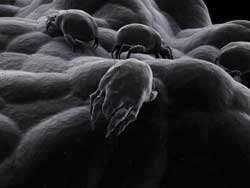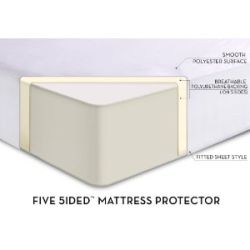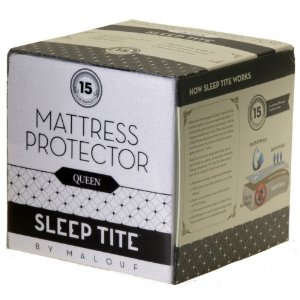What are Dust Mites?
If you have ever wondered "What are dust mites?" then this is for you. Dust mites are tiny, spider-like creatures with eight legs and a pincer-like mouth used for grinding up and digesting dander; dead skin and hair cells from humans and animals.
 You go to sleep with these guys everynight.
You go to sleep with these guys everynight.
The typical dust mite is approximately 0.3 mm large and it has a rather short life-span; one month for males and two months for females. However, during its life span a female dust mite has enough time to lay as many as 100 eggs.
Dust mites eat dander and since an average a human sheds about 10 grams of skin per week, dust mites have plenty of food. Add in how much house pets like cats and dogs shed and dust mites have an indefinite food supply. Dead skin from cats and dogs is commonly called dander.
What are Dust Mites - Where do They Live?
Their populations are largest where humans do the majority of their relaxing and spend the most of their time; couches, carpets, car seats, and of course, the bedroom; particularly in the mattress and pillow. Dependant upon conditions, 100,000 dust mites have been known to occupy one square yard of carpet, and millions can inhabit an entire mattress.
| A mattress that is ten years old can be double its original weight as a result of the acquired weight of dead dust mite carcasses and their feces. In order to prevent a dust mite infestation in your mattress, you need to pick up a dust mite bed cover. These covers will keep dust mites from getting into your mattress and it will keep the ones already in your mattress trapped inside and away from you. | |
| A two-year old pillow can have a 10% increase in weight due to the same reasons. Everyone needs a dust mite pillow cover. A cover on your pillow will keep dust mites from living close to you nose and mouth. |
Dust Mite Allergy Symptoms
What are dust mites? They cause allergies in many people. In fact, the symptoms of dust mite exposure are similar to other allergies. Someone allergic to dust mite allergens will experience the same symptoms as hay fever.
- Itchiness
- Sneezing
- Eczema (fancy word for skin rash)
- Red, watery eyes
- Runny nose
These symptoms can be treated with over the counter medications like an antihistamine. For severe reactions your doctor can prescribe medication for you. As always consult your doctor before you take any medicine.
What are Dust Mites - Getting Rid of Them
Dust mites thrive in warm, humid conditions. They do not drink water; however, they do absorb moisture from the air. They cannot survive without this moisture, so when looking for how to get rid of dust mites, keeping a cool, dry house will make a significant difference and will help to drastically reduce the number of unwanted occupants living under your roof.
What are Dust Mites - Why are They Bad?
Not only are dust mites a nuisance, they are also responsible for a large percentage of allergies in all people.
A compound in the feces of a dust mite emits certain antibodies, which when inhaled or ingested by humans, causes an allergic reaction. Symptoms can include itchy, red, watery eyes; sore, dry throat; dry cough; sneezing and tightness of the chest. If an individual who suffers from a dust or pollen allergy or who is an asthmatic comes into contact with dust mites and their feces, these symptoms can be escalated dramatically, and could cause serious health risks such as an asthma attack.
Dust mites and dust mite bites can even aggravate skin conditions such as eczema. House dust consists of a blend of approximately 28 allergenic components. Typically, dust mite allergens account for the vast majority of harmful components of dust, more than any other single particulate.
As they are so tiny, dust mite allergens can become airborne by simply walking across a room, opening a door, or rolling over in bed (an action that occurs approximately 50 to 60 times per night), and naturally, as a result of activities such as making your bed. These are merely a few of the actions that can cause dust mites as well as their accompanying allergens to become and remain airborne for up to two hours at one time before settling all through the entire house.
While airborne, these allergens are easily inhaled and become connected to the living cells that line the walls of the lungs. Once attached, they can suffocate and kill your healthy lung cells, which can cause permanent damage. Dust mites practice coprophagia, meaning, in times when food is scarce, they will substitute their own fecal pellets as a food source. Dust mite fecal pellets, which contain "guanine" and digestive enzymes, are a major cause of allergies across the world. The powerful enzymes in the fecal pellets break up hard-to-digest food for later nourishment. It is enzymes such as these that cause and trigger allergic reactions in humans by breaking down delicate living tissue including healthy lung cells.
What are Dust Mites - What Can You Do to Protect Yourself?
Dust mites can be a problem even if you aren't allergic to them right now. Many American homes have a high concentration of dust mites. This means someone who is not allergic to them now could develop an allergy to them.
Everyone should take steps to eliminate dust mites. Here are three simple things that will kill dust mites.
- Exposure to temperature over 140 degrees Farhenheit
- Exposure to temperature under 32 degrees Farhenheit
- Commercial dust mite sprays
Using any of the three above things will kill dust mites.
What are dust mites going to do when you start killing them?
Who cares?
Dust Mite Prevention Plan
It is not just enough to kill the dust mites. You need a plan to prevent their return. Honestly, nothing will ever completely rid your home of dust mites. However, you can take steps to greatly reduce their presence in you house. These steps will also reduce the symptoms of a dust mite allergy.
- Use a mattress cover
- Use an air purifier
- Clean your house regulary
- Vacuum with a HEPA filter
Trying to find out how to kill dust mites can take a lot of time. However, it is very important to reduce the number of dust mites and allergens surrounding you and your family. You need to keep a clean, un-cluttered, dust-free home as part of a dust mite prevention plan.







New! Comments
We would love to here what you have to say.